Bus Route Sketching: A Multimetric Analysis from the User’s and Operator’s Perspectives
Abstract
1. Introduction
2. Literature Review and Research Direction
2.1. Literature Review
2.2. Research Directions
3. BRS Methodology
3.1. Concept of Methodology
3.2. Setting up Bus Traffic Zones
- Define the full set of cell members () as , consisting of partitioned into unit cells (100 m × 100 m), and the cell member list () as , consisting of [cell center coordinates , population (), and the number of workers ()].
- Define the set of traffic zones () as The th traffic zone () has a member list () of cells, with , consisting of the center point of the traffic zone (), the center coordinates of the member (), the population (), and the number of workers (). for the ·traffic zone () is defined as follows:
- Once the general traffic zones are established through the above process, the transit traffic zones are determined using the transit demand generated by the bus stops located within the established traffic zones. The transit traffic zone concept introduced in this study is effective in deriving more reasonable bus route alternatives that account for transfers and connections with other bus routes while significantly reducing the number of possible bus routes with the BRS methodology. When designing and adjusting routes, it is not possible to account for all transfers that occur due to the intersection or partial overlap of routes, and routes are designed around transit stations. Therefore, transit zones are defined as traffic zones with high transit demand among general traffic zones. In addition, it is not possible to consider transfers in all traffic zones where transfers occurred at least once; so, it is necessary to select representative transit traffic zones.
3.3. Candidate Bus Route Alternatives
3.4. Ranking Bus Routes
3.4.1. Choosing Evaluation Indicators
3.4.2. Scoring Evaluation Indicators
4. Results and Discussions
4.1. Evaluation Design and Bus Traffic Zoning
4.2. Results of the Bus Route Alternative Exploration Analysis
4.3. Analyzing the Metrics and Selecting the Best Alternative
5. Conclusions
Author Contributions
Funding
Institutional Review Board Statement
Informed Consent Statement
Data Availability Statement
Conflicts of Interest
References
- Kim, K.T.; Lee, I.M.; Kwak, H.C.; Min, J.H. An Evaluation of curvature for bus lines using smart card data in Seoul. Seoul Urban Res. 2015, 16, 113–122. [Google Scholar]
- Lee, S.Y.; Park, K.A. Quantitative evaluation indicators for the city bus route network. J. Korea Soc. Transp. 2003, 21, 29–44. [Google Scholar]
- Faghihinejad, F.; Zoghifard, M.M.; Amiri, A.M.; Monajem, S. Evaluating social and spatial equity in public transport: A case study. Transp. Lett. 2023, 15, 1420–1429. [Google Scholar] [CrossRef]
- Yang, S.K.; Chang, H.B. Development and application of social equity indicators for evaluation of bus networks. J. Korea Inst. Intell. Transp. Syst. 2016, 15, 24–35. [Google Scholar] [CrossRef]
- Yao, D.; Xu, L.; Li, J. Evaluating the performance of public transit systems: A case study of eleven cities in China. Sustainability 2019, 11, 3555. [Google Scholar] [CrossRef]
- Kim, S.H.; Sim, T.I. The Analysis of efficiency for the city bus route operation using DEA: Focused on Suwon city. J. Korea Soc. Transp. 2021, 39, 264–279. [Google Scholar] [CrossRef]
- Lao, Y.; Liu, L. Performance evaluation of bus lines with data environment analysis and geographic information systems. Comput. Environ. Urban Syst. 2009, 33, 247–255. [Google Scholar] [CrossRef]
- Litman, T. Evaluating transportation equity. World Transp. Policy Pract. 2005, 8, 50–65. [Google Scholar] [CrossRef]
- Lee, S.J.; Choi, J.S.; Baek, H.S. A Study on the optimal urban bus network design using the set covering theory. J. Korea Soc. Transp. 1999, 17, 137–147. [Google Scholar]
- Park, C.G.; Cho, S.K. A Study on the optimization of Suwon city bus route using GWR model. J. Korean Soc. Geospat. Inf. Syst. 2014, 22, 41–46. [Google Scholar] [CrossRef]
- Lee, Y.J. Optimizing Express Bus Route and Operation Scheme with Smart Card Travel Data. Ph.D. Dissertation, Ajou University, Suwon, Republic of Korea, 2016. [Google Scholar]
- Boghani, A.B.; Kimble, E.W.; Spencer, E.E. Can Telecommunications Help Solve America’s Transportation Problem? A Multiclient Study; Arthur D. Little, Inc.: Cambridge, MA, USA, 1991. [Google Scholar]
- Alterkawi, M.M. A computer simulation analysis for optimizing bus stops spacing: The case of Riyadh, Saudi Arabia. Habitat Int. 2006, 30, 500–508. [Google Scholar] [CrossRef]
- Kimpel, T.J.; Dueker, K.J.; El-Geneidy, A.M. Using GIS to measure the effect of overlapping service areas on passenger boardings at bus stops. URISA J. 2007, 19, 5–11. [Google Scholar]
- Wuhan Transportation Annual Report 2012 (Blue Book); Wuhan Transport Planning Institute: Wuhan, China, 2012.
- Mangla, M.; Akhare, R.; Ambarkar, S. Implementing genetic algorithm to solve facility location problem. Int. Res. J. Eng. Technol. 2015, 2, 781–784. [Google Scholar]
- Murray, A.T. A Coverage Model for Improving Public Transit System Accessibility and Expanding Access. Ann. Oper. Res. 2003, 123, 143–156. [Google Scholar] [CrossRef]
- Pulugurtha, S.S.; Agurla, M. Assessment of Models to Estimate Bus-Stop Level Transit Ridership using Spatial Modeling Methods. J. Public Transp. 2012, 15, 33–52. [Google Scholar] [CrossRef]
- Andres, M.; Nair, R. A predictive-control framework to address bus bunching. Transp. Res. B Methodol. 2017, 104, 123–148. [Google Scholar] [CrossRef]
- Arriagada, J.; Gschwender, A.; Gschwender, M.A.; Munizaga, M.T. Modeling bus bunching using massive location and fare collection data. J. Intell. Transp. Syst. 2019, 23, 332–344. [Google Scholar] [CrossRef]
- Chow, L.F.; Zhao, F.; Liu, X.; Li, M.T.; Ubaka, I. Transit ridership model based on geographically weighted regression. Transp. Res. Rec. 2006, 1972, 105–114. [Google Scholar] [CrossRef]
- Fotheringham, A.S.; Brunsdon, C.; Charlton, M. Geographically Weighted Regression: The Analysis of Spatially Varying Relationships; John Wiley & Sons: Hoboken, NJ, USA, 2002; ISBN 978-0-471-49616-8. [Google Scholar]
- Tu, W.; Cao, R.; Yue, Y.; Zhou, B.; Li, Q.; Li, Q. Spatial variations in urban public ridership derived from GPS trajectories and smart card data. J. Transp. Geogr. 2018, 69, 45–57. [Google Scholar] [CrossRef]
- Wang, C.; Ye, Z.; Wang, W. A Multi-objective optimization and hybrid heuristic approach for urban bus route network design. IEEE Acess 2020, 8, 12154–12167. [Google Scholar] [CrossRef]
- Guerra, E.; Cervero, R.; Tischler, D. Half-mile circle: Does it best represent transit station catchments? Transp. Res. Rec. 2012, 2276, 101–109. [Google Scholar] [CrossRef]
- Zhao, F.; Chow, L.F.; Li, M.T.; Ubaka, I.; Gan, A. Forecasting Transit Walk Accessibility-Regression Model Alternative to Buffer Method. Transp. Res. Rec. 2003, 1835, 34–41. [Google Scholar] [CrossRef]
- Dill, J. The effect of neighborhood design on public transit use: A case study of San Francisco. Transp. Res. Part A Policy Pract. 2003, 37, 1–19. [Google Scholar]
- Lee, K.T.; Kim, I.K.; Shim, J.Y.; Kim, J.H. Improvement of Zone-based Regional Transportation Mode Choice Model Reflecting Behavioral Difference by Travel Distance. J. Korean Soc. Transp. 2020, 38, 346–360. [Google Scholar] [CrossRef]
- Tang, J.; Xu, L.; Luo, C.; Ng, T.S.A. Multi-disruption resilience assessment of rail transit systems with optimized commuter flows. Reliab. Eng. Syst. Saf. 2021, 214, 107715. [Google Scholar] [CrossRef]
- Javid, M.A.; Ali, N.; Hussain Shah, S.A.; Abdullah, M. Travelers’ attitudes toward mobile application–based public transport services in Lahore. Sage Open 2021, 11, 2158244020988709. [Google Scholar] [CrossRef]
- Oda, Y.; Fudaba, H.; Neubig, G.; Hata, H.; Sakti, S.; Toda, T.; Nakamura, S. Learning to generate pseudo-code from source code using statistical machine translation. In Proceedings of the 2015 30th IEEE/ACM International Conference on Automated Software Engineering (ASE), Lincoln, NE, USA, 9–13 November 2015; pp. 574–584. [Google Scholar]
- Thorndike, R.L. Who belongs in the family? Psychometrika 1953, 18, 267–276. [Google Scholar] [CrossRef]
- Syakur, M.A.; Khotimah, B.K.; Rochman, E.M.S.; Satoto, B.D. Integration K-means clustering method and elbow method for identification of the best customer profile cluster. IOP Conf. Ser. Mater. Sci. Eng. 2018, 335, 012017. [Google Scholar] [CrossRef]
- Liu, F.; Deng, Y. Determine the number of unknown targets in open World based on Elbow method. IEEE Trans. Fuzzy Syst. 2021, 29, 986–995. [Google Scholar] [CrossRef]
- Chang, H.H.; Lee, S.B.; Han, D.H.; Lee, Y.I. Methodology for estimation of link travel time using density-based disaggregated approach. J. Korea Inst. Intell. Transp. Syst. 2017, 16, 134–143. [Google Scholar] [CrossRef]
- Dion, F.; Rakha, H. Estimating dynamic roadway travel times using automatic vehicle identification data for low sampling rates. Transp. Res. Part B 2006, 40, 745–766. [Google Scholar] [CrossRef]
- Mouskos, K.C.; Niver, E.; Pignataro, L.J.; Lee, S.; Antoniou, N. TRANSMIT System Evaluation: Final Report; Institute for Transportation, New Jersey Institute of Technology: Newark, NJ, USA, 1998. [Google Scholar]
- Claire, P.; Dupont-Kieffer, A.; Palmier, P. Potential Accessibility to the Workplace by Public Transit and Its Social Distribution in Lille, France: A Scenario-Based Equity Appraisal. Transp. Policy 2022, 125, 256–266. [Google Scholar] [CrossRef]
- Banister, D. Unsustainable Transport; Routledge: London, UK, 2005; pp. 124–128. [Google Scholar]
- Maria, V.C.; Nicola, F. A Methodology to Evaluate Accessibility to Bus Stops as a Contribution to Improve Sustainability in Urban Mobility. Sustainability 2019, 11, 803. [Google Scholar] [CrossRef]
- Sun, C.; Quan, W. Evaluation of bus accessibility based on hotspot detection and matter-element analysis. IEEE Access 2020, 8, 138800–138809. [Google Scholar] [CrossRef]
- Handy, S. Regional Versus Local Accessibility: Implications for Nonwork Travel. In Transportation Research Record 1400; UCTC No. 234; National Research Council: Washington, DC, USA, 1993; pp. 58–66. [Google Scholar]
- Chapman, R.A.; Gault, H.E.; Jenkins, I.A. The Operation of ürban Bus Routes. Traffic Eng. Control 1977, 18, 364–367. [Google Scholar]
- Lownes, N.E.; Machemehl, R.B. Exact and heuristic methods for public transit circulator design. Transp. Res. Part B Methodol. 2010, 44, 309–318. [Google Scholar] [CrossRef]
- Saeed, K.; Kurauchi, F. Design of multimodal transit services with stochastic demand. Int. J. Transp. 2017, 5, 1–16. [Google Scholar] [CrossRef]

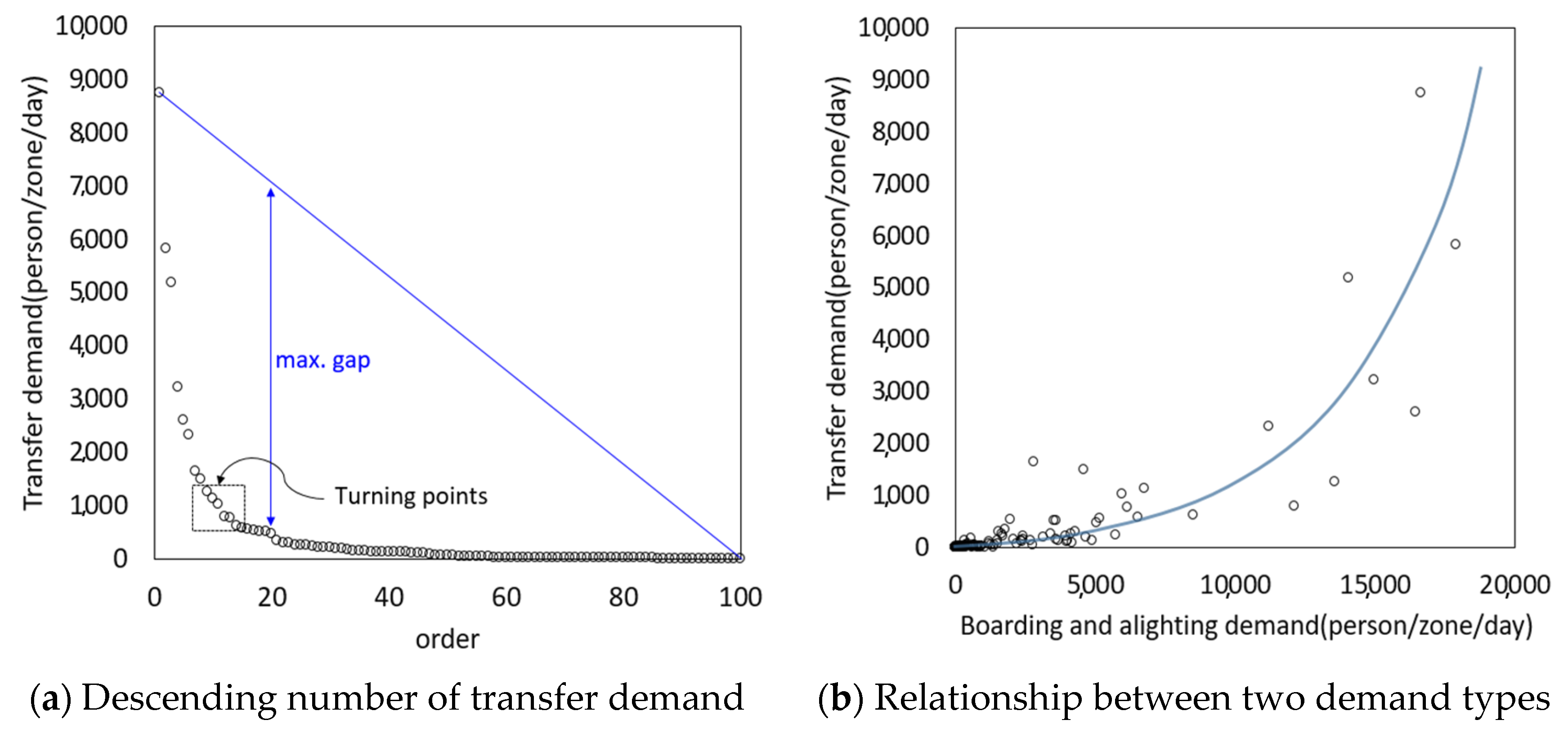

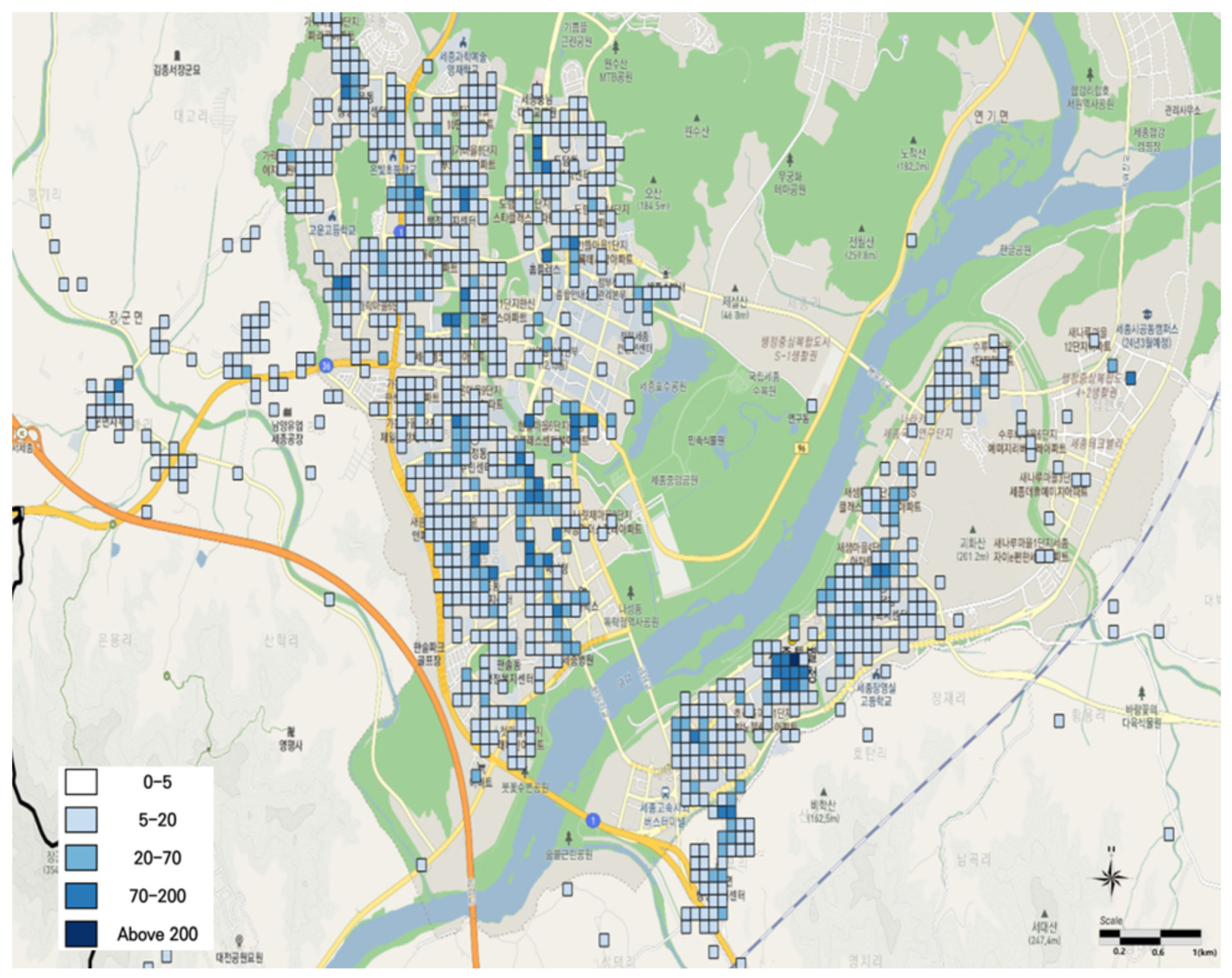
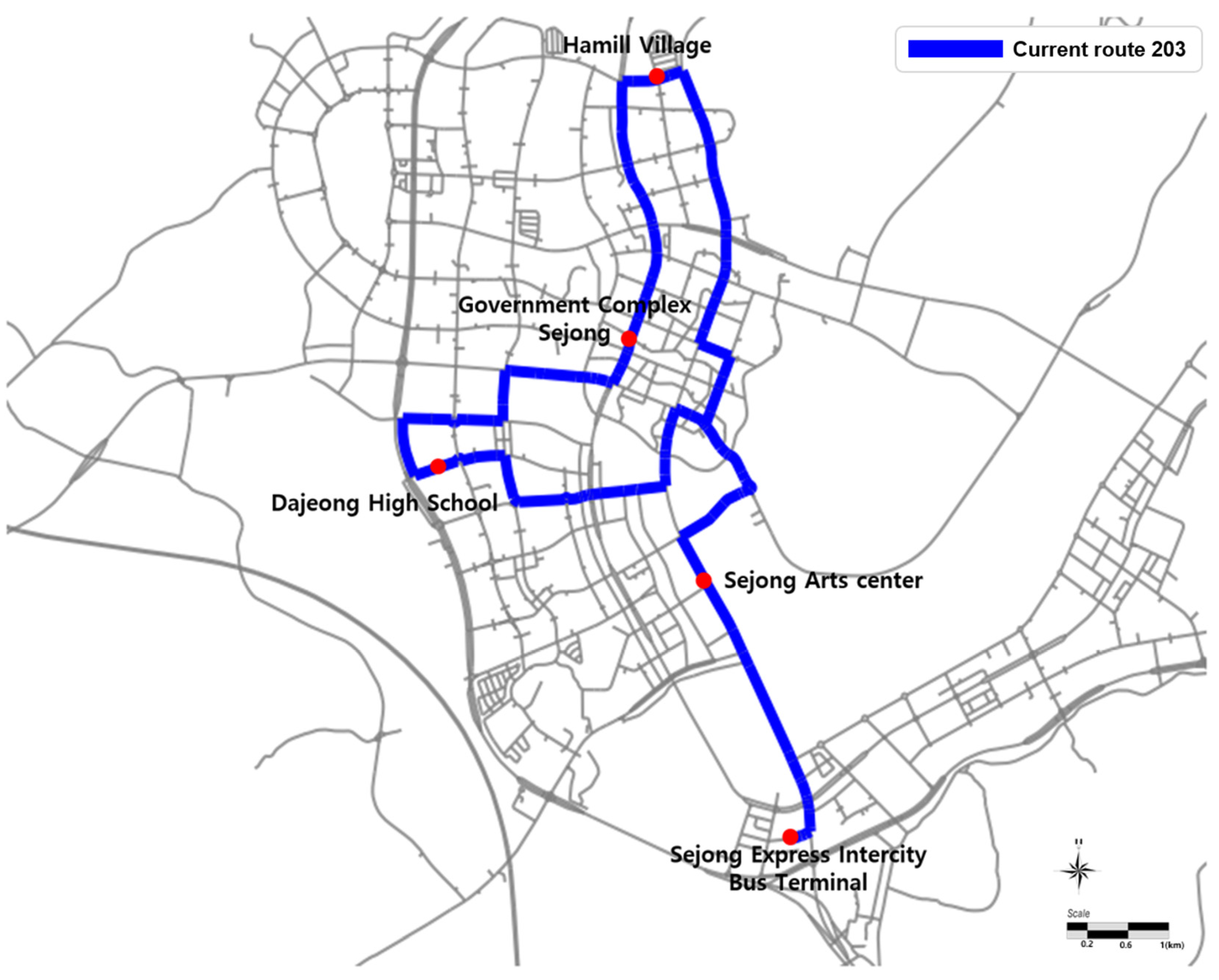
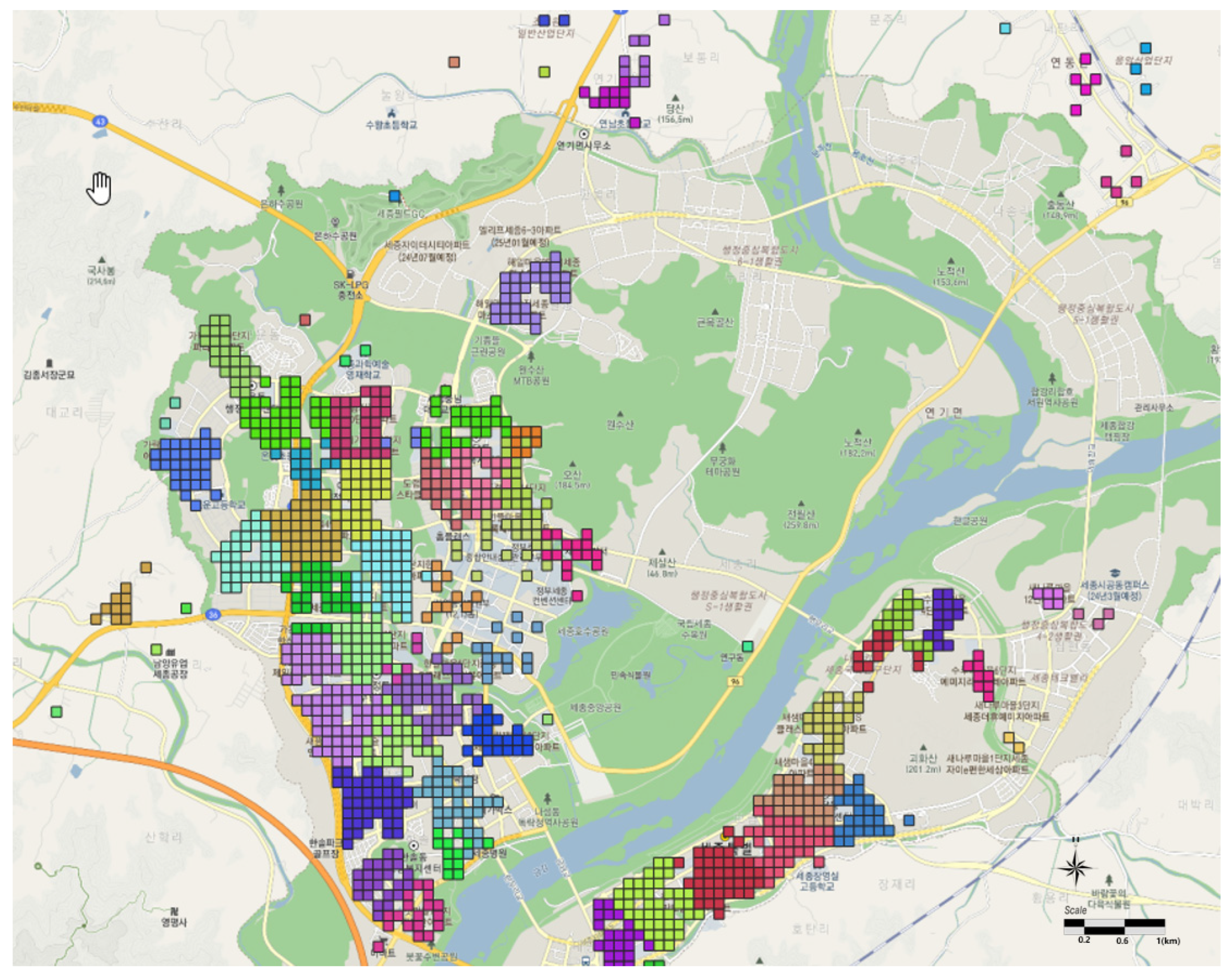
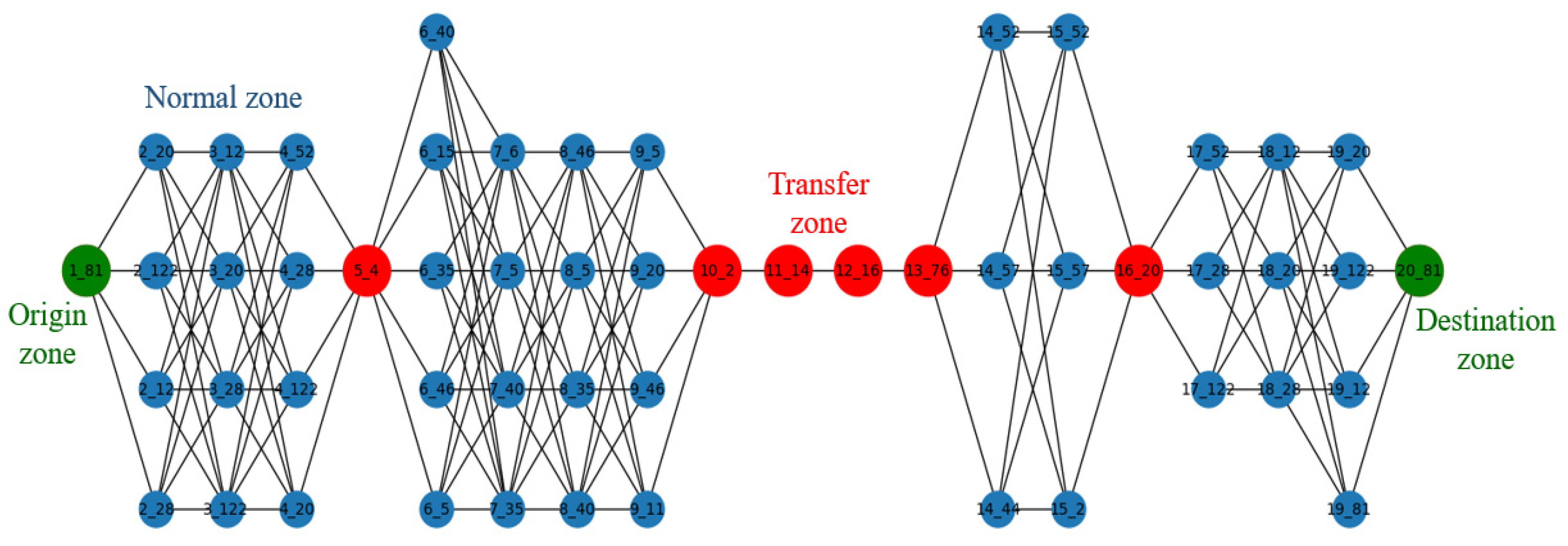


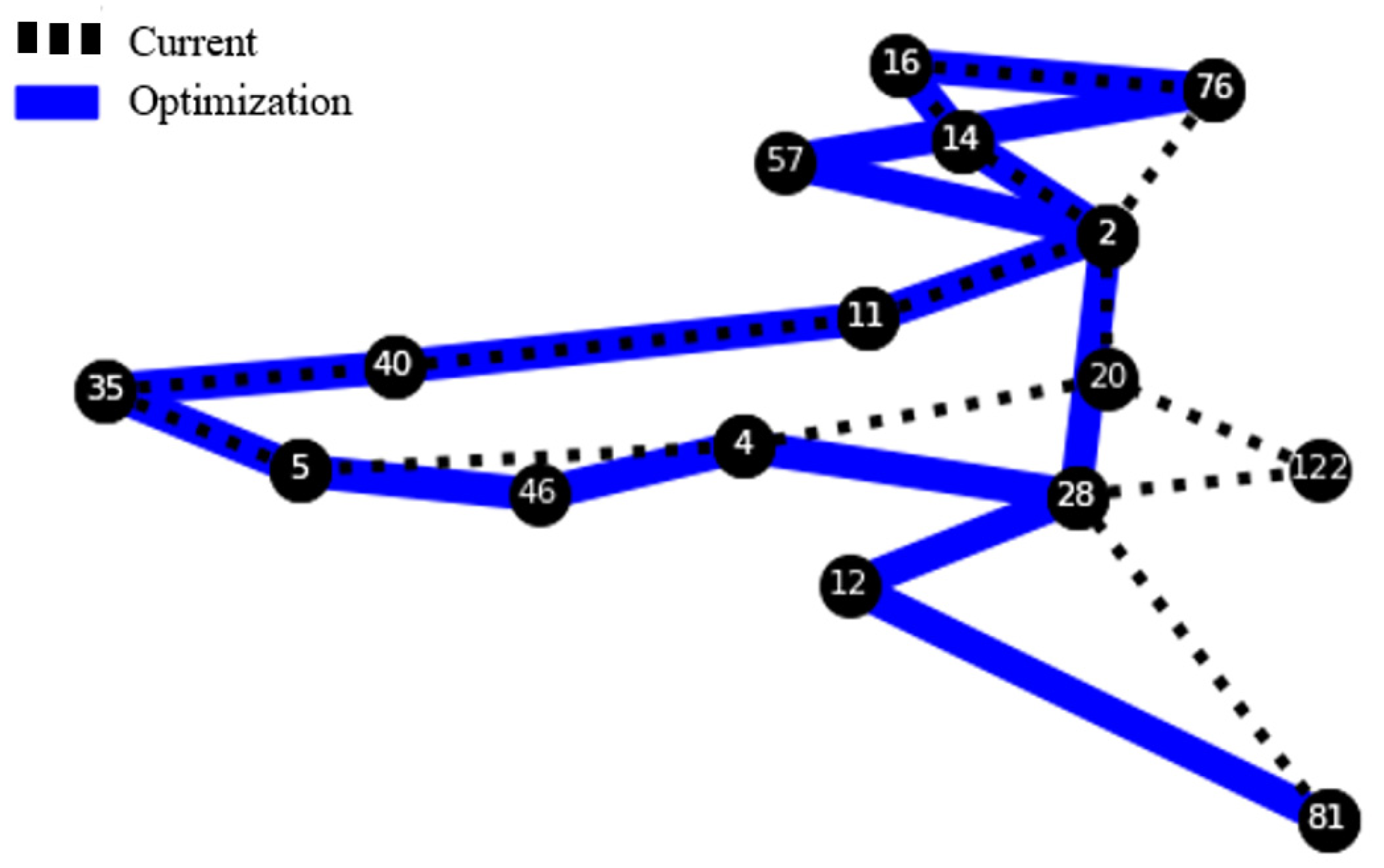


| Visit Order | Zone Type | Title 3 | ||
|---|---|---|---|---|
| Fixed | Visiting Zone Candidate | Visiting Zone Candidate List | ||
| 1 | 81 | - | - |  |
| 2 | - | 28 | 20, 122, 12, 28 | |
| 3 | - | 122 | 12, 20, 28, 122 | |
| 4 | - | 20 | 52, 28, 122, 20 | |
| 5 | 4 | - | - | |
| 6 | - | 5 | 40, 15, 35, 46, 5 | |
| 7 | - | 35 | 6, 5, 40, 35 | |
| 8 | - | 40 | 46, 5, 35, 40 | |
| 9 | - | 11 | 5, 20, 46, 11 | |
| 10 | 2 | - | - | |
| 11 | 14 | - | - | |
| 12 | 16 | - | - | |
| 13 | 76 | - | - | |
| 14 | - | 44 | 52, 57, 44 | |
| 15 | - | 2 | 52, 57, 2 | |
| 16 | 20 | - | - | |
| 17 | - | 122 | 52, 28, 122 | |
| 18 | - | 28 | 12, 20, 28 | |
| 19 | - | 12 | 20, 122, 81, 12 | |
| 20 | 81 | - | - | |
| Stakeholders | Performance Measures | As-is | Optimized by | ||
|---|---|---|---|---|---|
| Provider (SBI) | User (UBI) | Multi-Level (MBI) | |||
| Provider | PP | 330.80 | 375.74 | 336.80 | 349.95 |
| RC | 3.93 | 3.20 | 3.68 | 3.61 | |
| SBI | 8.83 | 9.99 | 6.40 | 9.50 | |
| User | PAD | 81,155 | 69,842 | 84,049 | 84,100 |
| TC | 1.79 | 1.31 | 1.40 | 1.43 | |
| UBI | 7.13 | 9.33 | 9.91 | 9.89 | |
| Multi-level | MBI | 7.48 | 9.66 | 8.16 | 9.70 |
Disclaimer/Publisher’s Note: The statements, opinions and data contained in all publications are solely those of the individual author(s) and contributor(s) and not of MDPI and/or the editor(s). MDPI and/or the editor(s) disclaim responsibility for any injury to people or property resulting from any ideas, methods, instructions or products referred to in the content. |
© 2024 by the authors. Licensee MDPI, Basel, Switzerland. This article is an open access article distributed under the terms and conditions of the Creative Commons Attribution (CC BY) license (https://creativecommons.org/licenses/by/4.0/).
Share and Cite
Jang, J.; Cho, Y.; Park, J. Bus Route Sketching: A Multimetric Analysis from the User’s and Operator’s Perspectives. Sustainability 2024, 16, 7172. https://doi.org/10.3390/su16167172
Jang J, Cho Y, Park J. Bus Route Sketching: A Multimetric Analysis from the User’s and Operator’s Perspectives. Sustainability. 2024; 16(16):7172. https://doi.org/10.3390/su16167172
Chicago/Turabian StyleJang, Junyong, Yongbin Cho, and Juntae Park. 2024. "Bus Route Sketching: A Multimetric Analysis from the User’s and Operator’s Perspectives" Sustainability 16, no. 16: 7172. https://doi.org/10.3390/su16167172
APA StyleJang, J., Cho, Y., & Park, J. (2024). Bus Route Sketching: A Multimetric Analysis from the User’s and Operator’s Perspectives. Sustainability, 16(16), 7172. https://doi.org/10.3390/su16167172







